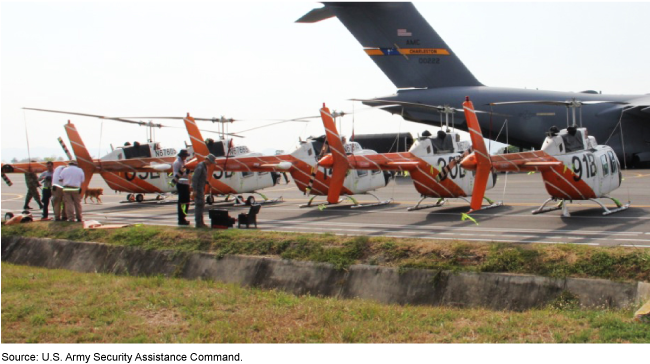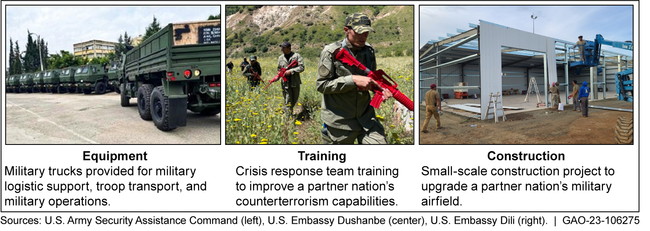Building Partner Capacity: DOD Should Assess Delivery Delays in Train and Equip Projects and Improve Evaluations
Fast Facts
In FYs 2018-2022, the Department of Defense allocated more than $5 billion to improve partner countries' ability to address threats like terrorism and drug trafficking. These projects provided equipment, training, services, and construction to national security forces.
But 75% of the projects' deliverables were delayed, limiting the projects' success. Also, DOD evaluations of projects' effectiveness were not high quality—for instance, evidence and findings weren't clearly linked to conclusions.
We recommended that DOD systematically identify and analyze the factors contributing to delivery delays and improve its project evaluations.
Helicopters provided by DOD to the Regional Helicopter Training Center in Melgar, Colombia.

Highlights
What GAO Found
In fiscal years (FY) 2018 through 2022, the Department of Defense (DOD) allocated nearly $5.6 billion through Section 333—one of its largest security cooperation programs—to build the capacity of partner nations' national security forces to conduct certain operations. This funding supported projects intended to provide equipment, training, services, and construction activities to the security forces of at least 90 partner nations to address threats such as terrorism and narcotics trafficking. DOD allocated nearly 16 percent of this funding to projects in Lebanon and Jordan. In FYs 2019 through 2022, 77 percent of allocations supported projects related to maritime and border security operations and counterterrorism operations.
Examples of Assistance DOD Has Provided to Partner Nations through Section 333

DOD delivered most Section 333 project activities after the estimated dates but does not monitor aggregate timeliness and has not analyzed the causes of delays. GAO's analysis of DOD data found that as of the end of FY 2022, 75 percent of deliveries were delayed relative to DOD's estimated dates. DOD monitors individual deliveries' timeliness but has not established a performance measure, such as a targeted percentage, that would let it regularly assess aggregate timeliness. Also, DOD has not systematically identified and analyzed factors contributing to delivery delays. Setting a performance measure for aggregate timeliness and systematically analyzing factors causing delays would help DOD ensure effective corrective measures.
DOD's evaluations of six Section 333 projects it completed in FYs 2017 through 2022 showed mixed results, but these evaluations were not high quality. DOD evaluations showed that four of the six projects improved the capabilities of partner nations' security forces and two projects did not because of unsuitable or unreliable equipment. However, GAO's analysis of the extent to which the evaluations met criteria for quality found weaknesses in their design, implementation, and conclusions. For example, the basis of the evaluations' conclusions was generally unclear, because the evaluations did not explain how evidence had been collected or summarized. Improving the quality of Section 333 project evaluations would help DOD to understand whether its projects were effective and to apply lessons learned from the evaluations to the development of new projects.
Why GAO Did This Study
DOD uses security cooperation programs, including those authorized by Section 333 of title 10 of the U.S. Code, to build the capacity and capability of partner nations to address various global threats. DOD is required to report to Congress on the status of its Section 333 projects and to evaluate the efficiency and effectiveness of its security cooperation programs.
The FY 2022 National Defense Authorization Act includes a provision for GAO to review Section 333 assistance. This report examines (1) DOD's allocation of funding for Section 333 assistance in FYs 2018 through 2022, (2) the extent to which DOD delivered Section 333 assistance to partner nations as scheduled, and (3) the findings of DOD evaluations of Section 333 projects as well as the extent to which the evaluations met criteria for evaluation quality.
GAO analyzed DOD data for Section 333 projects, reviewed DOD evaluation policies and other relevant documents, and compared six Section 333 project evaluations to criteria for quality. GAO also interviewed DOD officials and contractors.
Recommendations
GAO is making four recommendations to DOD to improve the timeliness of its Section 333 project deliveries and the quality of its project evaluations. DOD agreed with GAO's recommendations.
Recommendations for Executive Action
| Agency Affected | Recommendation | Status |
|---|---|---|
| Department of Defense | The Secretary of Defense should ensure that the Director of DSCA establishes a performance measure, such as a targeted percentage for on-time deliveries for Section 333 projects, that will allow it to regularly assess and monitor the aggregate timeliness of deliveries for Section 333 projects. (Recommendation 1) |
DOD concurred with this recommendation. In April 2025, DSCA officials said the agency was developing a "Methods to Measure Impacts" process that could be used to measure acquisition timelines and other aspects of deliveries for Section 333 projects. In addition, officials said new performance monitoring plans could be used to measure dates beginning with fiscal year 2026 Section 333 projects, which will help the agency develop a targeted percentage for on-time deliveries for fiscal year 2027 projects. DOD officials indicated that they plan to complete this process by October 2026. We will continue to monitor DSCA's efforts to establish performance measures for the timely delivery of Section 333 projects.
|
| Department of Defense | The Secretary of Defense should ensure that the Director of DSCA works with implementing agencies to systematically identify and analyze factors contributing to delivery delays for Section 333 projects. (Recommendation 2) |
DOD concurred with this recommendation. In April 2025, DSCA officials said that the agency was automating lifecycle processes that would enable it to analyze data to assess and monitor the timeliness of deliveries for Section 333 projects. We will continue to monitor DSCA's efforts to identify and analyze factors contributing to delivery delays for Section 333 projects.
|
| Department of Defense | The Secretary of Defense should ensure that the Director of DSCA, in coordination with implementing agencies and other stakeholders, uses the results of its analysis of factors contributing to Section 333 delivery delays to develop an action plan to mitigate or prevent potential future delays. (Recommendation 3) |
DOD concurred with this recommendation. In February 2024, DOD officials said that DSCA planned to develop an action plan to identify feasible measures to mitigate potential future delays. In April 2025, DSCA officials said that the agency was working to standardize tracking of acquisition timelines and logistics and materiel deliveries. Officials said that these efforts included business process improvements, dissemination of documented best practices, training of security cooperation officers, and new or enhanced automated tools. We will continue to monitor DSCA's efforts.
|
| Department of Defense | The Secretary of Defense should ensure that the Director of DSCA takes steps to improve the quality of Section 333 project evaluations to better align with international best practices, such as by including the reporting elements specified by the agency's evaluation instructions. (Recommendation 4) |
DOD concurred with this recommendation. The agency has revised the data collection and reporting templates used to evaluate Section 333 projects. In March 2025, DSCA began using the new templates to assess, monitor, and evaluate Section 333 projects. In addition, DSCA officials said that the agency provides regular feedback to the contractor conducting evaluations to ensure evaluations meet agency standards. In July 2025, officials said that the agency was working to develop standard operating procedures to implement the evaluations of projects' effectiveness by early fiscal year 2026. We will continue to monitor DSCA's efforts to improve Section 333 project evaluations.
|
